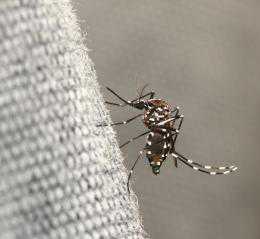PLoS Pathog.:首次发现基孔肯雅病毒能够直接在细胞间传播
2012-07-20 ZinFingerNase 生物谷
伊蚊(Aedes),图片来自iStockphoto/Roger De Marfà 基孔肯雅病毒(Chikungunya virus)已在非洲、亚洲以及最近在欧洲导致传染病流行。它通过伊蚊(Aedes)传播到人类。基孔肯雅病毒感染的症状包括急性发热,同时还伴随着能够持续几天、几周或者甚至几年的关节疼痛。如今,来自新加坡的研究员Lucile Warter和他的同事们鉴定出该病毒的两个区域,而且这两个

伊蚊(Aedes),图片来自iStockphoto/Roger De Marfà
基孔肯雅病毒(Chikungunya virus)已在非洲、亚洲以及最近在欧洲导致传染病流行。它通过伊蚊(Aedes)传播到人类。基孔肯雅病毒感染的症状包括急性发热,同时还伴随着能够持续几天、几周或者甚至几年的关节疼痛。如今,来自新加坡的研究员Lucile Warter和他的同事们鉴定出该病毒的两个区域,而且这两个区域能够被人抗体所识别从而中和掉这种病毒。研究人员有第一次证实这种病毒能够直接地进行细胞间传播。这些发现可能有助于解释这病病毒如何能够躲避胞外中和抗体( neutralizing antibody)的结合而增加感染效率。
为了发现抗体结合位点,研究人员将病毒与之前鉴定出的抗体一起孵育,然而分离出产生抗性的病毒变异株。测序和结构分析揭示抗性变异株在几个区域发生突变,这意味着这些区域是抗体结合位点。这些突变位于病毒的融合环“槽”和病毒包膜蛋白E2结构域B中。已证实结构域B在中和抗体识别相关的RNA病毒中发挥着重要作用。根据对抗性变异株的分析结果,研究人员猜测基孔肯雅病毒可能能够直接地进行细胞间传播。Warter和同事们通过在含有中和抗体的培养基中将遭受病毒感染的细胞与未感染的细胞一起培养,而证实了这一猜测。很多新的细胞被病毒感染,但是在细胞外并没有检测到病毒颗粒。
利用显微镜检测遭受病毒感染的细胞也表明在细胞间接触点,病毒颗粒浓度增加。直接进行细胞间病毒传播有利于直接传播大量病毒颗粒到其他能够开始复制的细胞中,同时又不会发生病毒进入胞外空间的风险。不过,还需开展进一步研究以便鉴定出与这种传播途径相关的分子机制,同时还需研究这种传播是否能够在体内发生。
本文编译自Investigation of Chikungunya virus yields two new antigens for vaccine development

doi:10.1371/journal.ppat.1002390
PMC:
PMID:
Chikungunya Virus Neutralization Antigens and Direct Cell-to-Cell Transmission Are Revealed by Human Antibody-Escape Mutants
Chia Yin Lee1, Yiu-Wing Kam1, Jan Fric1, Benoit Malleret1, Esther G. L. Koh1, Celine Prakash1, Wen Huang1, Wendy W. L. Lee1, Cui Lin2, Raymond T. P. Lin2,3, Laurent Renia1, Cheng-I Wang1, Lisa F. P. Ng1,3, Lucile Warter
Chikungunya virus (CHIKV) is an alphavirus responsible for numerous epidemics throughout Africa and Asia, causing infectious arthritis and reportedly linked with fatal infections in newborns and elderly. Previous studies in animal models indicate that humoral immunity can protect against CHIKV infection, but despite the potential efficacy of B-cell-driven intervention strategies, there are no virus-specific vaccines or therapies currently available. In addition, CHIKV has been reported to elicit long-lasting virus-specific IgM in humans, and to establish long-term persistence in non-human primates, suggesting that the virus might evade immune defenses to establish chronic infections in man. However, the mechanisms of immune evasion potentially employed by CHIKV remain uncharacterized. We previously described two human monoclonal antibodies that potently neutralize CHIKV infection. In the current report, we have characterized CHIKV mutants that escape antibody-dependent neutralization to identify the CHIKV E2 domain B and fusion loop “groove” as the primary determinants of CHIKV interaction with these antibodies. Furthermore, for the first time, we have also demonstrated direct CHIKV cell-to-cell transmission, as a mechanism that involves the E2 domain A and that is associated with viral resistance to antibody-dependent neutralization. Identification of CHIKV sub-domains that are associated with human protective immunity, will pave the way for the development of CHIKV-specific sub-domain vaccination strategies. Moreover, the clear demonstration of CHIKV cell-to-cell transmission and its possible role in the establishment of CHIKV persistence, will also inform the development of future anti-viral interventions. These data shed new light on CHIKV-host interactions that will help to combat human CHIKV infection and inform future studies of CHIKV pathogenesis.
本网站所有内容来源注明为“梅斯医学”或“MedSci原创”的文字、图片和音视频资料,版权均属于梅斯医学所有。非经授权,任何媒体、网站或个人不得转载,授权转载时须注明来源为“梅斯医学”。其它来源的文章系转载文章,或“梅斯号”自媒体发布的文章,仅系出于传递更多信息之目的,本站仅负责审核内容合规,其内容不代表本站立场,本站不负责内容的准确性和版权。如果存在侵权、或不希望被转载的媒体或个人可与我们联系,我们将立即进行删除处理。
在此留言








#基孔肯雅病毒#
20